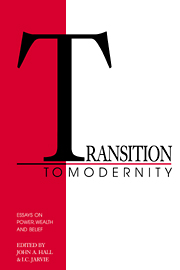Book contents
- Frontmatter
- Contents
- List of illustrations
- List of contributors
- Introduction
- PART I THE PRE-MODERN WORLD
- 1 World languages and human dispersals: a minimalist view
- 2 Nomads and oases in Central Asia
- 3 Why poverty was inevitable in traditional societies
- PART II TRANSITIONS TO THE MODERN WORLD
- PART III MODERNITY AND ITS DISCONTENTS
- Indexes
2 - Nomads and oases in Central Asia
Published online by Cambridge University Press: 02 February 2010
- Frontmatter
- Contents
- List of illustrations
- List of contributors
- Introduction
- PART I THE PRE-MODERN WORLD
- 1 World languages and human dispersals: a minimalist view
- 2 Nomads and oases in Central Asia
- 3 Why poverty was inevitable in traditional societies
- PART II TRANSITIONS TO THE MODERN WORLD
- PART III MODERNITY AND ITS DISCONTENTS
- Indexes
Summary
The whole history of Central Asia may be, and must be, to a large extent conceived as interaction between sedentary population and pastoral nomads, particularly those migrating to and settling in the area. The aim of this paper is to demonstrate that oases were the focal points in this process, and that an influx of nomads into Central Asian oases strongly affected their ethnic composition and socio-political characteristics.
Central Asia comprises the area which is flanked in the north by the Aral Sea and the Kazakh steppes, in the south by the Kopet-Dagh and Hindu Kush, in the west by the Caspian Sea, and in the east by the Pamirs.
Central Asia and the northern parts of Inner Asia, along with several other regions, constitute the vast geographical zone of Eurasian steppes, semi-deserts and deserts which stretch from the Danube to North China. This temperate zone of Eurasia may be subdivided more or less neatly into areas favourable for irrigation agriculture and areas favourable for extensive pastoralism. Together these forms of economic activities were possible only on the banks of rivers and inland reservoirs, and also in mountain piedmonts and valleys. However, the regions of mixed economy were nothing more than small enclaves interspersed among wide territories occupied by nomads.
In Central Asia proper, and in the steppes to the north, dry farming in the form of so-called bogar agriculture, and smallscale irrigation agriculture, were located mainly in mountain regions and in the foothills. These forms of cultivation were usually combined with extensive pastoralism. Agriculture with irregular irrigation and kair agriculture were practised in the lower reaches of the rivers, particularly those with a variable annual flow.
- Type
- Chapter
- Information
- Transition to ModernityEssays on Power, Wealth and Belief, pp. 69 - 90Publisher: Cambridge University PressPrint publication year: 1992
- 2
- Cited by



